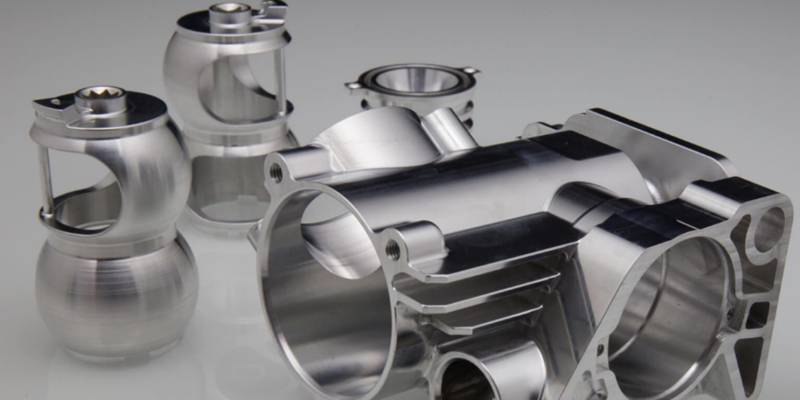- October 7, 2022
Whenever you have a manufacturing project, choosing the suitable material for your production falls on you. Aluminum and titanium are excellent metal options with various applications in different industries. Before you can choose between titanium vs. aluminum for your project, it would be best to understand the differences in their properties.
This article will discuss the properties of titanium and aluminum, their pros and cons, and their different applications. This will help you make informed decisions for your next project. Follow closely as we dive in!
Titanium vs. Aluminum: Comparing Their Properties
When handling a project, you should consider materials with impeccable properties such as strength and lightweight. Aluminum and titanium come to mind because they fulfill requirements such as resistance to corrosion, heat tolerance, and more.
As a result, it would help to analyze the differences between aluminum and titanium to choose a suitable material for your project.
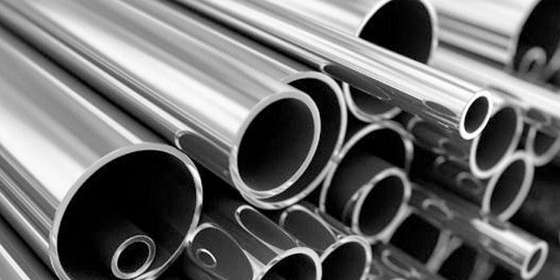
Elemental Composition
Generally, some components are not ideal for certain applications due to their elemental composition. In addition, added characteristics from other elements may improve the mechanical properties of some metals. Titanium consists of oxygen, nickel, nitrogen, iron, carbon, and hydrogen. Titanium is the main elemental composition, with other constituents varying between 0.013 and 0.5%.
In contrast, aluminum has different constituents, including aluminum as its primary composition. Others include zirconium, zinc, chromium, silicon, magnesium, titanium, manganese, iron, copper, and many more.
Thermal Conductivity
A material’s thermal conductivity determines its ability to conduct or transfer heat. If your project needs material with a good radiator, you may have to choose one with a high conductivity rate. Also, materials with low thermal conductivity are good insulators.
Alloys of aluminum possess high thermal conductivity of 210 W/m-K compared to titanium with 17.0 W/m-K. As a result, aluminum is suitable for heat sinks, heat exchangers, and cookware.
Electrical Conductivity
Electrical conductivity is a material’s property that permits electron flow to travel through it due to a drop in potential. Copper is a standard measure used to determine the electrical conductivity of a material.
Titanium shows about 3.1% of copper’s electrical conductivity compared. It proves that titanium has minimal electrical conductivity and is unsuitable for applications where good conductivity is a primary factor. Although titanium is not a suitable electrical conductor, it is good for making resistors.
On the other hand, aluminum possesses 64% of copper’s conductivity, making it a better option than titanium. As a result, it is a more suitable metal for projects where electrical conductivity is essential.
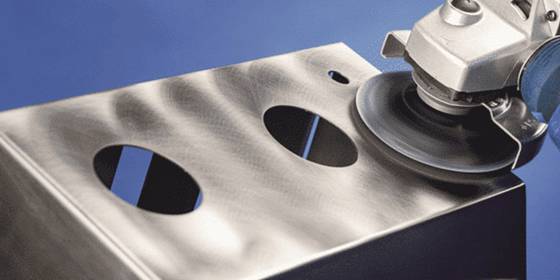
Strength
The strength of a metal is its resistance to non-recoverable deformation. However, strength varies depending on the metal used or the application involved.
Here are some of the different forms of titanium vs. aluminum strength:
●Yield Strength
A metal’s yield strength is its maximum stress at which it starts to deform permanently. Commercially pure titanium is a material with low-to-moderate strength. As a result, it is not the appropriate material for aircraft structures or engines. This is because it has a yield strength of high-purity titanium varying from 170 MPa to 480 MPa, which is considerably low for heavily loaded aero-structures.
In comparison, pure aluminum shows yield strength ranging from 7 MPa to 11 MPa. Alloys of aluminum have yield strength between 200 MPa and 600 MPa.
●Tensile Strength
The tensile strength of titanium alloys at a moderate temperature varies from 230 Mpa for the softest grade commercially pure titanium to 1400 Mpa for high-strength alloys. In addition, titanium’s proof strength ranges from 170 Mpa to 1100 Mpa depending on the quality and condition.
In contrast, alloys of aluminum show greater strength compared to pure aluminum. Pure aluminum shows a tensile strength of 90 Mpa. However, you can increase the tensile strength of some heat-treated aluminum alloys to over 690 Mpa.
●Shear Strength
This is a material’s resistance against structural failure before it fails in shear. The shear failure involved in the shear strength commonly occurs parallel to the direction of the force acting on a plane. Titanium shear stress varies from 40 to 45 Mpa depending on the property of the alloy.
Meanwhile, aluminum has shear stress that goes from 85 to 435Mpa. As a result, it has a better shear strength than titanium. You may want to consider some grade of aluminum over titanium if shear strength is a significant factor.
Density and Hardness
Both titanium and aluminum are lightweight metals for several applications. Aluminum (2712 kg/m³) has a lower density when compared to titanium (4500 kg/m³). Although titanium is two-thirds heavier than aluminum, aluminum’s density is much lower.
The metal’s hardness is the comparative value of a metal in response to deformation, scratching, etching, or denting along its surface. Titanium is generally harder than aluminum. But some alloys of aluminum show higher hardness than titanium, such as AA6082 temper T5 & T6, AA7075 temper T7 & T6, and more.
Therefore, aluminum is your best choice when you need a lightweight metal, while titanium is your best choice for hardness.
Melting Point
The melting point of a metal is the temperature at which it begins to change from solid to liquid states. The solid and fluid state of the metal exists in a balanced condition at this temperature. When the material reaches this temperature, it forms easily for use in thermal applications.
Titanium possesses a higher melting point of 1650 – 1670 ᵒC. It makes it a suitable refractory metal. On the other hand, aluminum has a lower melting point than titanium at 660.37 ᵒC. As a result, titanium is the appropriate material for use in cases of heat resistance application.
Corrosion Resistance
Both aluminum and titanium have excellent corrosion resistance properties, but one is more resistant than the other. Titanium is a non-reactive metal. As a result, it has high corrosion-resistant characteristics. It is more suitable for medical applications due to its bio-compatibility.
Alloys of aluminum are inert to corrosive elements dues to their layer of oxides. However, the corrosion of these alloys relies on atmospheric factors like chemical composition, temperature, and airborne chemicals.
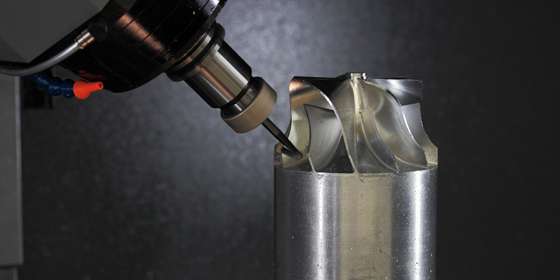
Machinability and Formability
The machinability score of a metal determines the appropriate machining process to use. At the same time, formability is the ability of metals to pass through plastic deformation without damage. CNC turning and milling are standard processes for producing components using titanium and aluminum. They provide tighter tolerances of +/- 0.005.
Complex geometries and machining waste influence the machining of material. You may consider using inexpensive aluminum instead of titanium machining to avoid wastage when producing components with intricate geometric designs.
Also, aluminum is more easily formed than titanium because aluminum is easy to fabricate using any method. You can cut it using several ways depending on the property of the material. Therefore, aluminum is more suitable when formability is a priority.
Properties Chart: Difference Between Titanium and Aluminum
| Property | Titanium | Aluminum |
| Atomic number | Its atomic number is 22 or 22 protons | Its atomic number is 13 or 13 protons |
| Ultimate Tensile Strength (UTS) | It possesses a tensile strength of up to 1170MPa | It has an ultimate strength of 310MPa |
| Melting Point | Titanium melts at 1650 – 1670 ᵒC | Aluminum melts at 582 – 652 ᵒC |
| Electrical Conductivity | Titanium has a low electrical conductivity | Aluminum exhibits excellent electrical conductivity |
| Magneticity | It is paramagnetic | It is not magnetic |
| Strength | It has double the strength of aluminum | It has a lower strength than titanium |
| Thermal Conductivity | Low thermal conductivity | High thermal conductivity |
An Overview of Titanium
Titanium is a radiant transition metal with a silver color, high strength, and low density. It has a unique corrosion resistance property and excellent thermal conductivity. Also, It has great corrosion resistance, making it suitable for marine applications.
Titanium’s thermal expansion is relatively low as it doesn’t absorb heat; instead, it reflects it. Its strength and safety make it an excellent material for medical equipment such as knee replacement, dental implants, pacemakers, and many others.
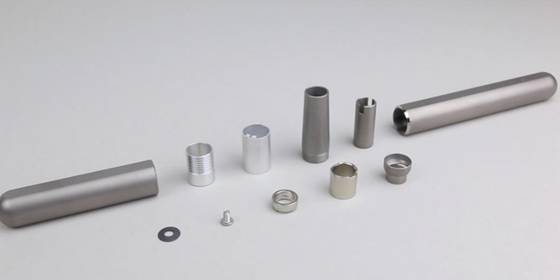
Pros and Cons of Titanium
Pros
- Highest strength-to-density ratio
- A most preferred alternative to steel
- Rust and corrosion resistant
- High resistance to stress conditions
- Excellent durability
- Suitable for so many products
Cons
- Requires high cutting force because of its high strength
- Low elasticity modulus
- Cost more than aluminum
Applications of Titanium
Titanium is a popularly used metal with many applications in several industries. Although titanium has downsides, many industries choose its benefits over these difficulties. These are some of Titanium’s applications:
Consumer and Architectural – used for spectacle frames, laptop parts, bicycle parts, etc.
Aerospace industry – used for making parts like hydraulic systems, firewalls, aerospace fasteners, landing gear, and other essential structural components.
Industrial application –used for valves, sputtering targets, process vessels, heat exchangers, and other parts.
Healthcare sector – for making surgical instruments, surgical implements, dental implants, and more.
An Overview of Aluminum
Aluminum is a flexible, usually soft, silvery-white, and non-magnetic material for metal machining. It is economical and easy to machine. It has a high fracture toughness and good corrosion resistance. Aluminum has many vital mechanical properties, making it suitable for many applications.
For instance, you can use aluminum as a conductor because of its excellent electric conductivity. However, It reacts poorly to acids but corrodes quickly in an alkaline environment.
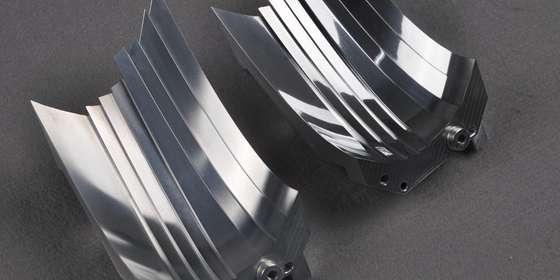
Pros and Cons of Aluminum
Pros
- It is a cheaper option
- Odorless and impermeable
- Reflectivity and flexibility
- High machinability and recyclability
- Corrosion Resistance
- High thermal conductivity and electrical conductivity
Cons
- Difficult welding process
- Corrodes quickly in salt water
- It may affect the tastes of packaged food
Applications of Aluminum
Aluminum is famous for its outstanding rust-resistance and electrical conductivity. These qualities make it a valuable and suitable material for producing different parts in different industries. Its main applications include
Machinery and Equipment – pipes, tools, and several processing materials.
Electricity – related applications – motor transformers, generators, conductor alloys, and more.
Household items – cooking utensils, air conditioners, refrigerators, and several others.
Transportation industries – aircraft, spacecraft, marine vessels, trains, and more.
Titanium Vs. Aluminum: Which Metal Should You Choose?
While aluminum and titanium are excellent choices for a wide variety of applications, they are not fit for every project. Before choosing a metal for your unique applications, you must consider several factors, including the following:
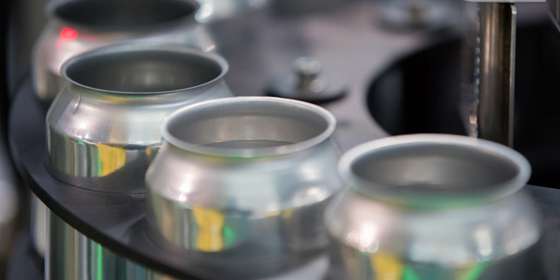
Applications
The respective properties of titanium and aluminum make them ideal for various applications. For instance, titanium is perfect for applications that require heat-resistant materials. These include medical applications, satellite components, marine components, and fixtures.
Meanwhile, aluminum is suitable for vehicle and bicycle frames, heat sinks, electrical conductors, small boats, and other applications needing high thermal conductivity.
Optional Machinability Processes
The material you choose for your project determines the geometrics of your final products. Also, it determines the machining method used for the material while producing your parts. Aluminum is more compatible with a wide range of processes. It provides high-quality components in cases when you need to make parts quickly.
Also, This material is easier to work with than titanium and is the better option for making intricate parts with tight tolerance requirements.
Cost
Cost of production is one of the fundamental factors you must consider when choosing a metal for your project. Generally, aluminum is a cost-effective metal used for precision machining and many other prototyping processes. Fabricating components is often cheaper with aluminum than with titanium.
Titanium has high extraction and fabrication cost compared to aluminum. Its high price limits its application. However, titanium is an ideal material for your machining purposes if the machining cost of titanium is not a challenge.
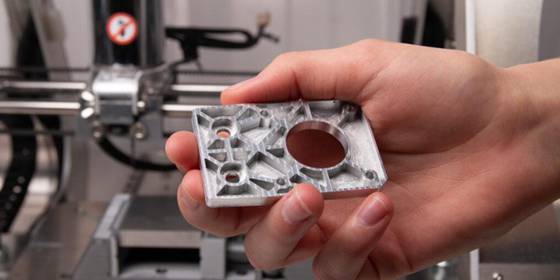
Weight and Strength
Titanium vs. aluminum weight and strength are other differences between these metals. Titanium has a density of 4500 kg/m3 in contrast to the 2712 kg/m3 of aluminum. As a result, titanium is heavier when compared to aluminum. This means you require less titanium in your machining to have a lightweight product.
Titanium is the better choice when it comes to strength. Its tensile strength varies from 230 MPa to 1400 MPa compared to aluminum, which has a margin of 90 MPa to 690 MPa. Pure titanium has low power, while pure aluminum is weaker. However, you can combine aluminum with other metal alloys to enhance its strength based on your needs.
Waste Produced
Machining waste is another crucial factor when handling complex design geometrics projects. Complex design geometrics may limit your machining method regardless of your chosen material. As a result, milling away excess material becomes inevitable. Sometimes, most producers utilize aluminum for prototyping and titanium is used for small batch production of special purpose products. In most cases, choosing inexpensive aluminum over titanium is advisable as it helps to reduce overall cost.
Aesthetic Requirements
Some milled parts often require applying specific colors for aesthetic finishing. Titanium gives a silver surface look that appears darker when under the light. Meanwhile, aluminum has a silvery-white appearance. The material you choose will determine if your product has a silver or dull grey color. However, both materials can take various other metal surface finishing procedures like bead blasting, polishing, chrome plating, etc.
Conclusion
Titanium and aluminum are metals with remarkable properties, respective advantages, and applications. Despite having almost similar qualities, they have individual applications in which one is more suitable than the other. While titanium is ideal for heat-resistant applications, aluminum has the best thermal conductivity that your project needs.
Real-world applications demand that you use suitable materials for the best achievable results. At WayKen, with years of machining experience, our machinists are familiar with the characteristics of various metal materials, including aluminum and titanium. We will guide you in selecting an appropriate metal for the project. Get a quote and get DFM feedback today!
FAQ
Which Metal Lasts Longer Between Titanium and Aluminum?
Both metals possess outstanding durability properties and can use them for an extended period. Nevertheless, titanium comes first in terms of durability and rigidity. Its components last for years without wear or tear signs. Titanium has excellent corrosion resistance and lasts longer because it can withstand stress.
How Can I Differentiate Between Titanium and Aluminum?
It is pretty easy to differentiate titanium from aluminum using their specific colors. Titanium has a dark silver color, while aluminum usually varies from silvery white to dull grey on several surfaces. In addition, titanium feels much harder than aluminum. Aluminum usually rubs off a lump of soft material when filed, while titanium doesn’t.

